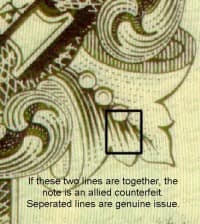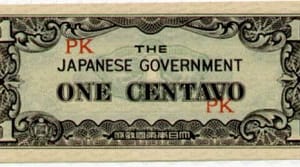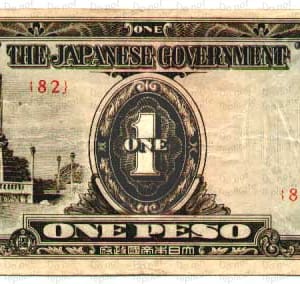PLEASE NOTE: JAPWANCAP WAS NEVER ACCEPTED AS A LEGITIMATE ORGANIZATION BY ANY GOVERNMENT. THE CERTIFICATES CANNOT BE REDEEMED. THEY ARE ONLY WORTH WHAT A COLLECTOR WOULD PAY FOR THE CERTIFICATES. A CERTIFICATE AND ALL DOCUMENTATION THAT GOES WITH IT WILL PROBABLY BE WORTH $10-$25 ON EBAY, BUT THAT IS ABOUT ALL.
JIM (Japanese Invasion Money) are usually worth ten to twenty five cents each, unless they are in perfect condition, then fifty cents to a dollar. If they are the replacement type, they could be worth a couple of dollars to even five dollars.
In August 1940, Japanese Prime Minister Matsuoka Yôsuke announced the idea of the Greater East Asia Co-Prosperity Sphere, a group of Asian nations led by the Japanese and free of Western powers; “Asia for Asians”. As Japan occupied various Asian countries, they set up governments with local leaders who proclaimed independence from the Western powers. One of the main ways to accomplish this was to have a unified currency, one that was not tied to western currencies.
Japanese Invasion Money was officially known as Southern Development Bank Notes. It is a currency that was issued by the Japanese Military Authority, as a replacement for local currency. In February 1942 Japan passed laws which established the Wartime Finance Bank and the Southern Development Bank. Both of these banks issued bonds to raise funding for the war. The former loaned money primarily to military industries. The latter is the one we are interested in here. They provided financial services in areas occupied by the Japanese military, and these Southern Development Bank notes were the Japanese Invasion Money we are now looking at.
Allied Forces counterfeit notes
On October 15th, 1943 MacArthur requested and received the following counterfeited notes for the Philippines:
five million 10-Peso notes
three million 5-Peso notes
one and a half million 1-Peso notes
five hundred thousand 50 centavo notes
The American forgeries are known to have the following block letter codes:
50 Centavo bills – PA, PB, PE, PF, PG, PH, PI
1 Peso bills – PH
5 Peso bills – PD
10 Peso bills – PA, PB, PC
It was further requested that one million Pesos, approximately the proportion indicated above, be dispatched to the Philippines by air as soon as possible and that the balance be dispatched by water transport.
For even more information on Allied counterfeit notes, refer to this article on psywarrior.com.

Another thing to note is that the Allied Forces created several counterfeit J.I.M. notes in an effort to devalue the currency and undermine the Japanese military authority.
Once the Japanese government made these notes, their military confiscated all hard currency in the Philippines, both from the government and the people. They replaced it with Southern Development Bank notes.
Now for an explanation of the method the Japanese used for adding serial numbers to most of these issues. They first used what are known as “Block Letters”, printed in red on the face of the note. This system has the first letter denoting the location issued: therefore, the Philippines had block letters which started with P. So for example, the Philippine notes would have on the front depending on when printed, a set of letters in red: PA, PB, PC all the way through PZ. These are known as “Whole Block Letters”.
When PZ was reached, one of two things happened- for the one through fifty centavos notes, it was decided to use what is called “Fractional Block Letters”. These were basically a fraction, but instead of numbers, it was letters, appearing like this: P/AA and this system worked in the same principal as before. The letter on top denoted the location, and the bottom two were the series, starting with AA and progressing as needed. When AZ was reached, it was advanced to BA and went through BZ, and on some issues, CA and so on to EZ. For the Pesos notes, serial numbering was introduced (as well as a design change).
Some denominations have letters skipped over. The reason for this is not known, but it is believed that so many of these notes were printed, they may not have been discovered yet. Even today, bundles of Japanese Invasion Money are being discovered under old huts, in tunnels and stuffed into caves.
The second issue peso notes (1, 5, 10 and 100 Pesos) had a block number and a serial number usually beginning with a zero. Some serial numbered notes begin with the number one. These notes were issued as replacements for damaged notes, much like American ‘star’ notes (although a lot harder to find!). The block number range of the notes with serial numbers is 1 – 79. On the one peso notes only, blocks 80 – 87 had no serial numbers (they were produced in haste after the Americans landed on Luzon- there were 5 print runs). These notes with just plate block numbers are much harder to find than the ones with serial numbers.
Also, after the liberation of the Philippines, the Red Cross came in to help out. They obtained many of these JIM notes, and punched 2 holes in each one. Then these hole-punched notes were distributed to the soldiers as souvenirs. These notes have no extra monetary value, but do come with a bit more of a story and can usually be found in high grades.
Regarding the legality of the JIM notes after the war, President Truman did not support the stance of the Philippine government. Commonwealth House Bill No. 647 (Senate Bill No. 51), titled “An Act Governing the Payment of Monetary Obligations Incurred or Contracted Prior to and During the Japanese Invasion of the Philippines and for Other Purposes,” was passed by both houses of the Philippine Commonwealth Congress on the last day of its last session, December 20, 1945. It was signed into law by President Osmeña on January 18, 1946. The law provided for the validation of payments made in Japanese “mickey mouse” money during the period of enemy occupation.


